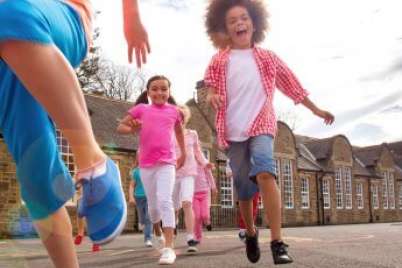
3 outdoor PE games to play during the pandemic
This school year, amid the COVID-19 pandemic, there are new rules and guidelines to follow, forcing educators to adapt their instruction.
In the school where I teach, for example, we have to get creative during physical education classes, as once-popular games such as tag are no longer considered safe.
Public health guidelines are clear about continuing to keep our safe distance. Nevertheless, kids still need to move, a lot. So how can we encourage daily doses of physical activity while staying apart? We adapt.
Tag may be out (for now) but there are plenty of fun activities educators can do with students that don’t involve close contact.
We’re lucky at my school as we’re surrounded by forested areas, making these active outdoor games particularly easy to play. However, a school playground with equipment and some natural environments can also provide an adequate playing field.
Here are three of our favourite tried-and-tested spins on the classic game of Hide and Seek, tailored for pandemic times.
Also in this series
PE during a pandemic: How to help your students focus on building skills
PE on the playground: 4 active games that use school playground equipment
PE on the playground: How to design an obstacle course
PE on the field or pavement: Group games for open spaces
PE in the forest: Group activities to develop movement skills in the woods
1. Tap the Cone/Tree
This is a version of “kick the can” that you might have played as a child. One person is the “seeker.” All the others must hide while the seeker counts to 30 at the designated tree or soft orange rubber cone.
Once the seeker is finished counting, they set off to find their classmates.
When they spot someone, they must call that person’s name and both race to the designated tree stump or cone to tap it.
If the seeker beats the hider to the destination, the hider must go to “jail.” If the hider beats the seeker, then the seeker must count again. In the meantime, the others can change their hiding spots if they want to.
If there are people in jail, anyone can try to race the seeker to tap the cone/tree and free their friends.
Related read: Could 2020 be the year of outdoor learning?
2. Camouflage
For this game, a wooded area on school grounds or nearby is ideal. Otherwise, a schoolyard with sufficient hiding places (such as playground equipment, a few trees or bushes, etc.) can work in a pinch.
One person is the “seeker” and they must stay within a designated space and position, such as with one foot on a tree stump, soft cone, or in a hula hoop. All the other players are hiding and camouflaging nearby. (Before playing, the teacher outlines the boundaries of the playing areas, as appropriate).
The seeker can call out various things that the players must respond to. For example:
- Make an animal sound: all the players must then make a sound, helping the seeker pinpoint where they are.
- Make a move: the hiders can shake a branch or gently toss
- Popcorn: players must quickly show an arm or leg, and then quickly hide it.
- Food for sale: this command gives hiders 20 seconds to run towards the seeker, who has their eyes closed, say their name, and then run and find a new spot. The next time this command is called, there are only 15 seconds, then 10, then 5. If the seeker spots you, you’re out.
The seeker can also ask the question, “How many fingers am I holding up?” to which the hiders must answer correctly, risking being seen. If their answer is wrong because they can’t see, they’re out.
Related read: How integrating outdoor play into the school day benefits children
3. Human Hunt
This is a popular hide-and-seek game (sometimes known as “manhunt”) that can easily be adapted to allow for physical distancing.
One “hunter” counts to 30 while everyone hides. When they find someone, they must run to get to about an arm’s length distance from that person (being mindful to respect physical distancing guidelines) and call the person’s name. This player, as with any subsequent players found, then joins the hunter in their search until all the players are found.
Can you adapt these games to suit your environment? Let us know how!
More physically distant active outdoor group games:
- 8 no-touch group games kids can play together
- 7 summer camp-style games to play while physical distancing
Marta Orellana teaches upper intermediate grades in a North Vancouver elementary school, where PE is generally taught by classroom teachers rather than PE specialist teachers.





